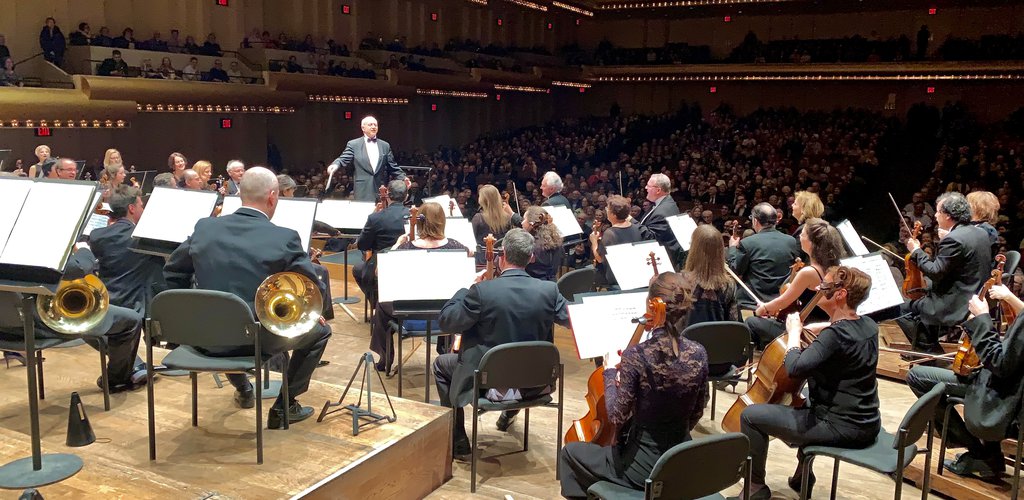Iván Fischer and the Budapest Festival Orchestra have taken New York by storm in recent years: their brilliant operatic performances made them a mainstay of the Mostly Mozart Festival for several seasons, and their many tours since have made them something of a local fixture. On Sunday afternoon, the orchestra scored another success with an all-Dvořák program in David Geffen Hall, as part of Lincoln Center’s Great Performers series. Critical review by Eric C. Simpson in New York Classical Review.
The concert opened with Dvořák’s Legend No. 10, an opportunity to show off the clear shine of the orchestra’s sound right at the start. The BFO boasts a bright, polished quality that doesn’t glare: here, the simple purity of their sound lent a narrative quality to the bittersweet melody.
It’s not often that you’ll hear an unaccompanied choral work on an orchestral concert: still less often that the orchestra will be doing the singing. Assisted by a dozen or so extra singers, the orchestra gave a lovely rendition of “Místo klekání” (Evening’s Blessing). Naturally, they didn’t have the crisp, pure sound of a professional choir, but in the rough edges of the music they conveyed a real folk spirit. Picking up their instruments again, the orchestra gave an energetic performance of the Slavonic Dance Op. 46, No. 7, keeping the essential, charming pulse of the dance always audible as Fischer guided it through a series of transformations.
Dvořák’s Violin Concerto, though hardly neglected, has never achieved quite the level of celebrity enjoyed by its other Romantic peers. Having neither the lyrical clarity nor the technical firepower of its cousins, the A-minor concerto can be a difficult piece to interpret.
Renaud Capuçon had trouble with exactly that in Sunday’s performance. The French violinist is a formidable player with confident technique and he coaxes out of his “Panette” del Gesù (the same violin played by Isaac Stern) a burning bright sound with a hint of gravel. Yet he never felt especially connected to the music, bringing a fine melancholy spirit to its main themes but feeling largely tepid in the supporting figures, without a sense of their purpose. His instrument, to be fair, is on the quieter side, forcing him to sacrifice detail for audibility, and the largely sleepy playing of the orchestra meant the accompaniment supplied little energy.
Capuçon found more focus in the Adagio, building his lines into lovely, high arches, yet again he struggled with volume; in prolonged double-stop passages especially, he managed little dynamic contrast. The Finale was the most convincing of the three movements, thanks to his bounding heroic spirit, though the folk dance in the development section was too poised and straight-laced to have much of a rustic feel.
As an encore, Capuçon offered the “Dance of the Blessed Spirits” from Gluck’s Orfeo ed Euridice. The quality of his tone here was breathtaking, a glowing sound that seemed to sail on the breeze, but without accompaniment the piece’s long phrases lost their rhythmic focus.
There was no such lack of direction in the BFO’s bracing performance of the Symphony no. 8 in G major. This was an expressive, big-hearted interpretation, opening with a warm wash of sound, and using a muscular articulation throughout the first movement to underscore its power and scope. Another blast of warmth opened the Adagio, but quickly resolved into the calm melody of the winds, floating serenely over the graceful stepwise figures of the strings. Fischer expertly guided his players through seamless transitions, as grand passages evaporated, giving way suddenly to tender, warm breezes.
In the Scherzo they spun a stylish waltz, combining flair and melancholy. The technical precision of the BFO’s playing made possible the rapid shifts between playfulness and poise, and the sweeping curves outlined by Fischer added emotional depth.
The stately tempo at the start of the finale quickly became a gallop, growing into a raucous celebration for full orchestra that reached its greatest heights with the aggressive blasts of the brass. Some tenderness came when the clamor dropped down to just a whispered melody in the cellos, but for the most part shining, crashing sound defined the performance, driving through to the bursting energy of the coda. As if to drive home the cheerful energy of the music, Fischer had his players laugh in time to punctuate one phrase, which the audience quickly answered in kind.
